A Trip to Scotland including the Western Isles
May 20-27, 2003
This is from my diary
When you find a star
Links yo my photos have no star.
Tuesday May 20
Start Arlanda Airport 09.10, arrival London Heathrow about ten o'clock ,
British Midland
New flight to Glasgow where we were met by our guide Lee Persson and saw the other members of the party.
 Our driver this time was Sarah, a nice and competent young women, and the coach came from . We entered the coach and the tour began with a drive along Loch Lomond under steep hills to the left where the bluebells (Hyacinthoides Non-scripta) was covering the ground like a blue carpet under the oaks. And to the right along the lake were nice gardens with rhododendron and other flowering bushes. When the road got narrower and the hills came more near the road borders were filled with wild flowering bushes, yellow gorse (Ulex Europaeus) and white hawthorn (Crataegus). On the other side of the lake the hills was towering, on the slopes sheep were grazing with small new lamb. The hills often got a yellow shade of the large of gorse. And here and there water came in a stream down the hillside . A very beautiful ride!
Our driver this time was Sarah, a nice and competent young women, and the coach came from . We entered the coach and the tour began with a drive along Loch Lomond under steep hills to the left where the bluebells (Hyacinthoides Non-scripta) was covering the ground like a blue carpet under the oaks. And to the right along the lake were nice gardens with rhododendron and other flowering bushes. When the road got narrower and the hills came more near the road borders were filled with wild flowering bushes, yellow gorse (Ulex Europaeus) and white hawthorn (Crataegus). On the other side of the lake the hills was towering, on the slopes sheep were grazing with small new lamb. The hills often got a yellow shade of the large of gorse. And here and there water came in a stream down the hillside . A very beautiful ride!
In Tyndrum we had a break at ![]() The Green Welly Stop the village centre with shop and café. The hills around us were shimmering in many nuances of yellowish brown greyish black and light green, blackish brown where the growth was heather. What colours there must be at autumn!
The Green Welly Stop the village centre with shop and café. The hills around us were shimmering in many nuances of yellowish brown greyish black and light green, blackish brown where the growth was heather. What colours there must be at autumn!
The couch rolled on, Lee told parts of Scottish history during the travel. E.g. the dark history of Glen Coe from 1692 when we passed the place of that treachery.
We had next stop at ![]() Glenfinnan where they have a monument for
Glenfinnan where they have a monument for ![]() "Bonnie Prince Charlie"
"Bonnie Prince Charlie"
The whole tour from Glasgow to Mallaig was a wonderful experience due to the beautiful nature in the glens between the hills. Ats Mallaig we stayed for the night at West Highland Hotel
Wednesday May 21
Early wake-up to get to the ferry for
We had a stop at the capital of Isle of Skye, Portree, where we could go shopping, have a walk in the harbour and then we had an excellent lunch with a salad of salmon with fresh potatoes and "sticky pudding" as dessert.
Embarked the coach again and now the road passed meagre tracts with mostly heather on the hills. On the hill above Uig Bay we stopped to look at the nice view of Uig village with white houses under yellow hills. That yellow colour due to mighty thickets of gorse (Ulex Europaeus).
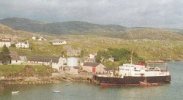 The ferry left at 2 PM and arrived in Tarbert on Isle of Harris at 3.30 PM. The coach drove northwards towards Stornoway, the capital of the Western Isles, the outer Hebrideans. The road was very narrow and went between high stony hills. Remote stony tracts. On the meagre hill slopes there were many grazing sheep with new lamb.
The ferry left at 2 PM and arrived in Tarbert on Isle of Harris at 3.30 PM. The coach drove northwards towards Stornoway, the capital of the Western Isles, the outer Hebrideans. The road was very narrow and went between high stony hills. Remote stony tracts. On the meagre hill slopes there were many grazing sheep with new lamb. When arriving in
And then - a violent change when arriving in
We arrived at "The Cabarfeidh", the hotel where we should stay for three nights. At last we could unpack our bags. And the blackbird was singing in the garden outside our room.
Thursday May 22
The weather was grey and rain was hanging in the air. The coach took us out over the barren land of the bogs to the west coast of the island. First stop at Arnol and the blackhouse museum.. You can read about the blackhouses
On the other side of the road was the ruin of another blackhouse. Just the stone walls. We could observe the plan of this type of houses. We also could enter a newer house in which people have lived until 1970 and all the furniture and kitchen utensils were to be seen.
March marigold (Caltha Palustris) was bright yellow in the ditch, in the grass white buttons of daisies (Bellis Perennis) and in the fields along the sea were grazing sheep and the larks was singing in the sky.
On to
A lady told us the story of the village, how people lived at the time the houses were habituated and then she demonstrated weaving of Harris Tweed.
I noticed that a starling must have her nest in the walls of one of the houses. The chirping from the small one's was heard all the time and the old bird came and dived into the slot in the wall. Yellow buttercups in the grass and everywhere the blackbirds song.
Stones- stones- stones everywhere. The fields were surrounded by stone walls - an evidence of the hard work which is behind the living here, these small cultivated fields. And the coach took us to a mighty building made of stones -
Friday May 23 grey morning and some rain. The tour of this day
20% of the inhabitants are of Norse origin. Nowadays there are 22000 inhabitants and 8000 of these live in Stornoway.
There are no forests in the isles, thus stone is the material for house building. During the latest decades they have planted trees, but some of the plantations are harmed by insects. We saw one of these plantations, a ghostly sight.
The dominating rock is gneiss, a very hard kind of stone, not easy to form. In earlier time they built the houses of the natural blocks you find in abundance in the ground. Ingenious and clever they have built the old houses in the villages out of these blocks.
The hills and moors are mostly treeless which is due to grazing sheep. Where there are no sheep we could see trees, e.g. in small islands in the lakes.
In Tarbert we visited SOAY Studio where a lady told us about dying of wool with herbs and lichen. She had proof of wool she had dyed and told us which herb and which method she had used to get those colours. We then could walk around in her garden where she grows some of the herbs she is using. But mostly she collects what she needs when walking around in the hills.
The coach drove along the eastern coast of south Harris. A winding narrow road named "The Golden Road" because it had been so expensive to build. We really award Sarah, our driver, for her good driving along these roads. The surroundings are barren, just stony bare hills and many waters, in lakes and firths. Lark over the land and seabirds in the lakes.
A stop in a small village Plockropool, where we met a tweed weaver in action.
We also observed some llamas in a field, so there are initiatives in these remote villages.
Our guide played some folk tones and told us that there is a rich tradition of singing in the villages. The amusements in the evening were often singing and dancing. But not at Sundays. The Sunday was holy. That is a thing I remember from our visit in Stornoway 1987. We were there a Sunday and nothing open. This tour was planned so we had no Sunday in the isles.
At Stockinish an old road is beginning leading over the hills to the western side of the peninsula. Our guides said it was named "The Coffin Road" as it was that way they transported the dead from the eastern side to the graveyard which is situated on the western side. There is no layer of earth deep enough so that you can bury the dead!
There was a windmill there too. They have plans to erect wind power stations at the isles. That must be good here as it is so windy.
The Medieval Church of Rodel, St Clement's, was our next goal. Beautifully situated in a rural churchyard where primroses and bluebells grow among the tombstones.
After a stop for lunch at Leverburgh we visited Northton and MacGillivary Centre. That is built according to old methods of building by stone in these islands. Craftsmen who are trying to teach the new generations how to build with the local stones have made the building. Inside the house there is a permanent show of the wildlife of seabirds and plants you find in the area.
The nature on the west coast of south Harris is quite different from the eastern coast. A great difference when coming the route we did. Here you find undulating grass slopes down at the sea, and large beaches. In the grass I found lots of minimum size flowers, daisies, violets, birds foot-trefoil, mountain speedwell and lots of others.
A small golf course is there too. The have confidence in their visitors as you put the fee in a blue box at the entrance!
We made a longer stroll along the beaches at Horgabost, a popular place for camping life summer time.
Saturday May 24 Time to leave the outer Hebrideans, but first we had a tour with our coach up to The Butt of Lewis, the utmost northern point of these isles.
The road along the western coast of Lewis goes through lots of small villages. The villages are long but not wide, the houses are situated along the roads. Apparently it is here those people live who don't live in town.
The grassy fields down to the sea are green and cows and sheep are grazing, We did not see as many stone walls along the fields as more southern, probably it is more fertile here. At the side of nearly every house we saw the ruin of the old blackhouse, but often overgrown by moss. These ruins at the side of every house are my greatest memory from the trip we had in 1987.
In the centre of northern Lewis the peat bogs are dominating the landscape. We saw a couple out digging peat.
The weather was ideal for strolling around on the poor grassy slopes around the lighthouse. Good temperature, hardly any winds, sunny but not hot. On the cliffs there grow thrift (Armeria Maritima) in masses, pink flowering at the barren stone. I tried to botanise in the grass and found some dwarft species of meadow flowers, e.g. campion (Silene Dioica), - just the flowers above ground and no stem !, birds foot-trefoil (Lotus Corniculatus), beach plantain (Plantago Coronopus) but there were few flowers at this season.
The cliffs went steel in the sea. The merganser sat in long black rows at the edge of the outer cliffs like black silhouettes against the waves. Yellow lichen clad most of the cliffs. Bright! I have experienced so many shades of the colours of nature this trip.
In one of the coves we saw some seal diving, sometimes putting their heads above water level.
Then we went to the community house in the village of Habost where we had a big tea meal with sandwiches and cakes. The local branch of the Scottish Historical Society is serving this on a non-profit basis.
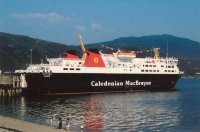 But now time to leave the Western Isles and return to Scotland mainland. The ferry "MV Isle of Lewis" left Stornoway at 2 PM and arrived at Ullapool at 4.35 PM. Ullapool is lying on the northern side of Loch Broom and the houses are shining white towards the hills. Rhododendron in flowers everywhere, a patch of colour together with the gorse under the seel hills.
But now time to leave the Western Isles and return to Scotland mainland. The ferry "MV Isle of Lewis" left Stornoway at 2 PM and arrived at Ullapool at 4.35 PM. Ullapool is lying on the northern side of Loch Broom and the houses are shining white towards the hills. Rhododendron in flowers everywhere, a patch of colour together with the gorse under the seel hills.The main road between Ullapool and Inverness went by at my opinion typical Scottish nature areas. At first along Loch Broom where the side of the hill above the road was covered by rhododendron and green leafy trees, a real contrast to the barren landscape out in the isles!
At a place I observed something like a steam over the trees to the left - and a look at my map said there is a ravine with a waterfall. (Falls of Measach, Corrieshalloch Gorge.)
The road mostly in the glens between high hills and everything was green, still springtime green. About the same as in Sweden this time of the year.
The last part of the drive Ullapool-Inverness goes through areas where farming seems to be an important industry. There were many great herds of cows grazing in the green fields, large fields of rape and other crops, but even forests, mostly oak or beech.
We arrived to Palace Hotel in Inverness opposite the Castle on the other side of Rover Ness, where we slept for three nights. And the blackbird was singing here too.
Sunday May 25 Big Scottish breakfast with everything you expect, e.g. porridge, haggish, black pudding. The breakfasts were the best at this hotel. The weather was changing with showers and sunshine.
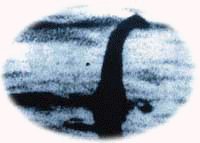 A drive to Loch Ness - shall we see the monster? Through the nice little village Drumnadrochit to Castle of Urquhart. No monster to be seen, just big black clouds but the rain took another way.
A drive to Loch Ness - shall we see the monster? Through the nice little village Drumnadrochit to Castle of Urquhart. No monster to be seen, just big black clouds but the rain took another way.Then back through Inverness to
After lunch we visited
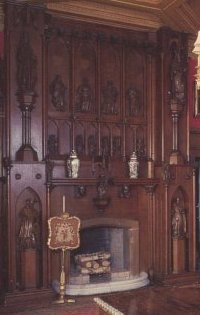 The library was imposing with all the volumes bound in leather. The carving on the mantelpiece in the Red Drawing Room was holding many figures.
The library was imposing with all the volumes bound in leather. The carving on the mantelpiece in the Red Drawing Room was holding many figures.The nursery was at the top of the tower - you should not see or hear the children! And there was a room for the nanny beside.
When leaving the castle we were met by a scent of summer - the source was a honeysuckle at the corner.
Back in Inverness we heard the chiming of many churches between 6PM and half past. Sunday evening and time for Evensong. Many of our party went to the Evensong in the nearby cathedral and they said the choir was very good. But as my husband was so tired we preferred to have a time of rest before the common dinner at "The Mustard Seed", a restaurant with a mustard yellow screen. We were told that the name was hinting at the word in St Luke 13:19. The dinner was excellent and we had a really good talk together during the meal. Afterwards we strolled along the river in the darkness enjoying the reflections of the lights of the town in the water.
Monday May 26
Towards
The interior decorations were in light colours and you did not have the feeling of being in a museum. Except the nursery high up in the tower above difficult stone stairs.
The Laird is very fond of gardening and her gardens were beautiful. The entrace walk to the castle was at this time of the year a tunnel of goldenrod. The rhododendrons were at its best and displaying many different colours.
We drove on along the Speyside. We noticed a shepherd on his tractor and his dog sorting the sheep in a fiels alongside the road. Many cows grazing in the area, but higher up in the hills sheep dominated the scene. The trees had not developed their leaves in full, size we in Sweden call "mouse ears", like at home in Färila when we left one week ago. Next stop at Walkers Shortbread in Aberlour where we visited the factory shop, and then on up in the hills to Cardhu.
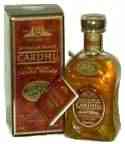 We had a guided tour through the Whisky Distillery and had the interesting story. Former in the long cold winters months, the farmers would take some barley and burn water, cut some peat upon the moor and distil some whisky for himself and his friends. The farm Cardhu has natural advantages. The clear water of the Mannoch Hill the peat of Dallas Moor and the barley from the fields of the farm were the finest ingredients to use. This distillery has most of its time been run by women. The distillery produces a single malt whisky made in the traditional way.
We had a guided tour through the Whisky Distillery and had the interesting story. Former in the long cold winters months, the farmers would take some barley and burn water, cut some peat upon the moor and distil some whisky for himself and his friends. The farm Cardhu has natural advantages. The clear water of the Mannoch Hill the peat of Dallas Moor and the barley from the fields of the farm were the finest ingredients to use. This distillery has most of its time been run by women. The distillery produces a single malt whisky made in the traditional way.Back in the hotel after dinner the whole party assembled in the bar and thanked our driver Sarah and our guide Lee and had a big cheer for them. They had made this tour memorable for us. And then definitely time to pack our bags. Perhaps a puzzle?
Tuesday May 27 the coach started for Edinburgh Airport, going road A9 through the highlands. A stop at
At noon on to the airport, and the flight to Sweden started at 3PM.
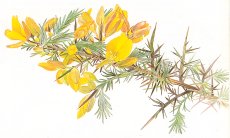
My best memories from this trip is all the different shades of the colours of nature.
Interesting to see parts of UK a bit off the beaten tracks.
The trends to a more definite nationalism and the strive for keeping the old characteristics and the origin languages which we have seen during the latest decades everywhere in our world was seen in the outer Hebrides too. The attitudes towards the Gaelic language seem to be more positive since 1987 when we visited these islands.
Our local guide mentioned that nowadays the parents can chose if they want their children in Gaelic or English school. That must be a sign that people are more conscious of their national characteristics and the value of keeping those alive.
A detail I noticed: I got the impression that the living circumstances are better for the inhabitants in the villages. The gardens are nicer, the ruins less noticeable, not so much trash around the houses. There are more cows in the fields on the west coast of Isle of Lewis.
The organization of the tweed weavers must have been invaluable for people in the villages. That is the cause that they have been able to survive here in this remote area. You can read about this
The tourist industry is very dependant of non-profit members of the organisations, e.g. The National Trust and the Historical Society of Scotland.

![]() Welcome, or as we say in Gaelic, Fàilte! We, the Gaelic speaking people of Scotland today welcome you.
Welcome, or as we say in Gaelic, Fàilte! We, the Gaelic speaking people of Scotland today welcome you.
![]() The Outer Hebrides information.
The Outer Hebrides information.
Some links to more information about Scotland
 Here is the Saga. The Thistle is the symbol flower of Scotland
Here is the Saga. The Thistle is the symbol flower of Scotland
Photo pages Scotland 2001 INDEX Diary Index
Background, photo and text made by © Ingegerd